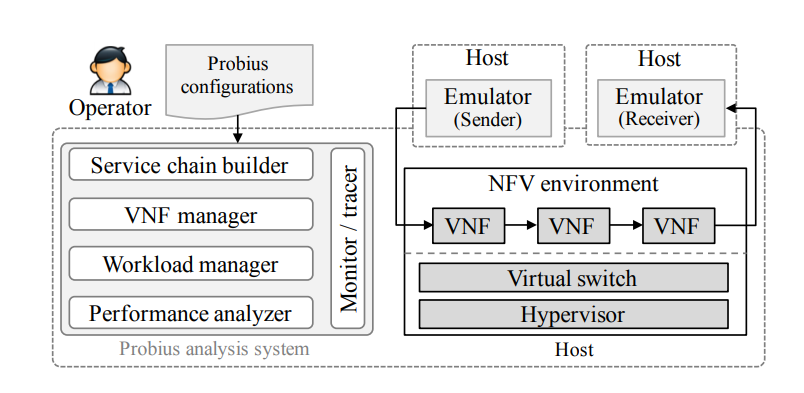We have discussed basics on VNFs and how going cloud-native can help to overcome automation challenges of VNFs in NFVi. This article focuses on challenges related to common information models, VNF performance monitoring, benchmarking; analysis and tools. We will also discuss on evaluation & selection of VNF lifecycle management vendor of NFV environment.
Performance of VNF in diverse NFV infrastructure
Apart from automation in development and consistent updates to VNFs, a performance of VNFs can be affected due to diverse NFV environment factors like different sort of workloads and contention among VNFs for resource utilization. Adding to this, NFV environment is built to support not just a single VNF but a chain of VNFs from different vendors to create a single service chain. The architecture of NFV environment should support the requirements by VNFs which are sharing same resources in NFVi. This results in overall NFV performance degradation which may cost heavily for service providers.
There are some frameworks and architectures proposed to tackle these concerns supported by practical demonstration in real-world scenarios. Let’s discuss 2 proposed frameworks in brief.
Use of Virtual Probe (vProbe) function for NFVi monitoring
Virtual Probe (vProbe) function can be used within NFVi for performance analysis of VNFs and NFVi elements. It itself is a VNF which replaces traditional hardware based probes to virtual or software functions. vProbe function can be integrated within NFVi by attaching it to virtual or physical resources and it can be deployed in NFVi in form of virtual machines, containers or a process within hypervisors which host VMs. Main job of vProbe is to monitor traffic among virtual network elements within NFVi and forward the generated data to higher level data analytics and management layer. Provided data is used to analyse performance of VNF and overall NFV elements in real time.
VNF Performance Analysis using Probius
Three students, Jaehyun Nam, Junsik Seo & Seungwon Shin; from South Korean public research university KAIST have developed a performance analysis system Probius. As stated in paper presented by ACM SOCM Conference 2018,
Probius automatically extracts all meaningful performance features from the NFV architecture, and discovers the reasons of performance problems. For this, Probius collects specific features from all NFV entities and sorts out performance anomaly through statistical regression approaches. To point out the root causes of the problems, it newly adopts the behaviour analysis of VNFs on the basis of the NFV architectural characteristics.
To demonstrate the system, they analysed 7 open source VNFs (formed into service chain) to show rigorous analysis results. Resulted analysis output suggested the performance issue which caused by the NFV environmental factors based on what kinds of VNFs are deployed and how VNFs are chained.

Image Source: https://conferences.sigcomm.org/sosr/2018/sosr18-finals/sosr18-final66.pdf
Gym, Automated performance testing framework
To address performance concern of VNF with diverse NFV environment, a new automated NFV performance benchmarking framework is proposed, called as Gym. Gym is an open source initiative termed as an evolution to Virtualized Network Functions (VNF) Benchmark-as-a-Service (VBaaS) which enables run time resource evaluation and VNF testing prior to deploy in NFV environment. Gym has evaluated its design principles and test scenarios on vIMS services.
Adoption of Common Information Model (CIM) by vendors
Common information model forms a base for NFV environment where VNFs and NFVi solutions from different vendors are supported with different NFV environment. It can help to optimize VNF on-boarding process on multivendor NFV infrastructure with varying orchestration processes to handle diverse workloads. With this model, VNF lifecycle management and service monitoring and control can be easily managed within NFV environment.
ETSI & other standard bodies attempted to harmonize all VNFs using common information model. But it was not adapted by vendors as it was increasing cost without much realizing benefits out of it. Ref
Intel has envisioned 5 phases for mature NFV by proposing maturity models; especially dedicated for telecom service providers to address all aspects of their business: business and service, technology, organization, governance and customer. Apart of focusing towards standalone VNFs, network function auto-scaling, SDN federation and full service automation; adoption common information model to direct vendors to characterize and provide network SLAs is taken into consideration in second phase.
Evaluating & choosing VNF lifecycle management solution provider
- Service providers are having 2 VNFM lifecycle management approaches to choose to enable automation; dedicated and generic. In dedicated approach, software dependencies and integration overheads are excessive and due to lack on interface standards cost of implementation is higher. In generic VNFM approach, there is less integration with added advantage of higher level of automation. Service provider must take a call on choosing one of the two approaches, however both approaches have benefits and pitfalls.
- VNF scaling is the key strength of many solutions but automated healing and patching/upgrading is hard to achieve for many solutions. Having most of the automated functionality can be key differentiator.
- Many VNF vendors and VNF lifecycle management solution providers have not followed the model which ETSI had recommended and interfaces for seamless on-boarding and automation are not full proof on every NFV infrastructure. Service providers should opt in for lifecycle management solution that can accumulate different types of VNFs and seamlessly integrate DevOps approach to achieve complete automation at VNF development, on-boarding level as well as NFV MANO level.
Summary
Role of NFV/SDN will be crucial for implementation of 5G network to support upcoming technologies like virtual reality, augmented reality, delivery drones, smart cities and self-driving cars which demands very high bandwidth with ultra-low latency. Real-time analysis and performance benchmarking before deploying VNFs on to NFVi is need of the hour. Major concern could be a well-defined and industry acknowledged CIM is missing in development phase of NFV and it raises challenges in NFV success realization. For service providers, choosing a VNF lifecycle management solution which follows generic and DevOps approach is also a concern which may have impact on NFV operations.
Based on all concerns we discussed in last article and this write up, to meet with all vectors (Flexibility, scalability, resiliency, agility and low cost) that characterize the NFV; overall recipe for NFV could be transformation of NFV operation towards cloud-native approach, adoption of common information model and utilization of automated performance benchmarking and analysis for VNFs should be on place.
References
- https://www.researchgate.net/publication/308541712_VBaaS_VNF_Benchmark-as-a-Service
- https://cloudify.co/2018/02/23/cloud-native-vnf-explosion-mwc18/
- http://www.analysysmason.com/Research/Content/Reports/choosing-a-vnf-lifecycle-management-solution-for-operators-white-paper/
[Tweet “NFV Concerns: VNF Performance Benchmarking & Analysis and Common Information Models (CIM) ~ via @CalsoftInc”]






